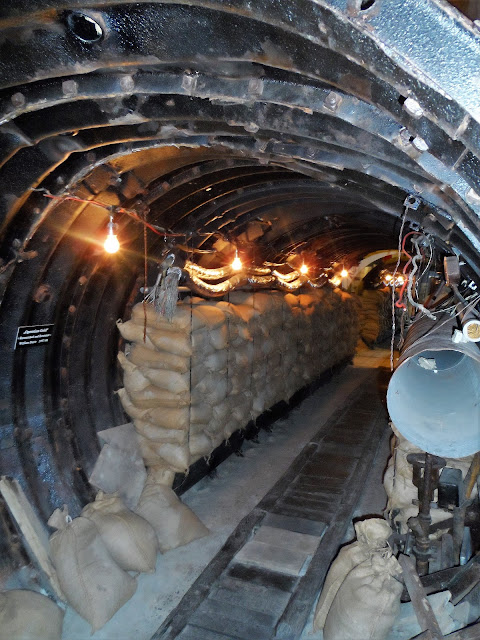We are parked up on a free motorhome Aire in Potsdam, next to a park (N52.41956 E13.04853) so Mel can visit his old ‘stomping ground’ from the 80's. Potsdam was the residence of the Prussian kings, princes and German
emperors and has the largest collection of UNESCO World Heritage sites in Germany! They created a fairy-tale
landscape of palaces, gardens, churches and parks.
Heading out of Berlin to Potsdam we stopped off at the Allied Museum, housed
in a former US Outpost Theatre and Nicholson Memorial Library. Through exhibits, film and video footage, it
tells the story of the Western powers in Berlin with the occupation of Germany
by American, British and French troops after their victory over the Third Reich
in WWII. For almost 50 years during the Cold War era, the western military presence shaped the city’s daily life and culture into what it is today.
 |
| Sculpture: 'The Day The Wall Came Down’ |
 |
| The 4 occupational Zones drawn up around Berlin after WWII |
Germany was to be treated as an administrative and economic unit and the
4 ‘Ds’ - Denazification, demilitarization, democratization and decentralization - were the guiding principal of the
occupation policy, with the transfer of the German population from Poland, Czechoslovakia
and Hungary to be done in a humane manner.
However, the Soviets chose to reorganise their zone of occupation along
Communist lines and refused to make a positive contribution towards the
democratic reconstruction of Germany, which led to the western powers
consolidating their zones and led to the Soviet Zone becoming the socialist
state of the GDR.
Up to 500,000 soldiers in East Berlin stood opposite 13,000 military
soldiers in West Berlin. Military reconnaissance
activities therefore became significant and military liaison missions of
western forces in Potsdam were able to engage in on-site observation of
military activities in the Eastern side and to recognise any potential military
plans.
Below shows part of a 450-metre long Berlin Spy Tunnel, dug by the
Americans and British running under the border of Berlin’s American and Soviet
sector. It was dug so they could tap phone
lines in East Berlin.
 |
| Part of a Berlin Spy Tunnel, dug by the American and British military |
 |
| The Tri-Mission Display |
 |
| Map detailing Permanent Restricted Areas (PRAs) |
Below, Mel is stood in front of the Hastings TG 503, one of many
aircraft that transported food and coal during the Berlin Airlift, ensuring that West Berlin survived when the Soviets (their former war ally) blocked the western part of the city in 1948/49. In the
background a French Military railcar and the last guardhouse from Checkpoint
Charlie – which gained international notoriety for the 1961 confrontation
between American and Soviet tanks.
 |
| In front of segments of the Berlin Wall and watchtower, proudly wearing a poppy that the British legion were selling in the museum |
This exhibit made us chuckle, as it reminded us of our time in
1987 when we ran the Berlin 25km around the west of the city and into the Olympic Stadium. The medals we received (and still have!) are
exactly the same.
This plaque sums it up nicely.
The next day we were up and out early so Mel could try and find the old
Potsdam Mission House, where he lived and worked from 1983-1986. We are not sure what it is used for now but there were lots of security
cameras and lights surrounding it, and this is about as close as we could get.
 |
| Former Potsdam Mission House |
 |
| Back of the Mission House from across Lake Heiliger - almost like Mel was back in his 'spying days' zooming in on this! |
 |
| Looking cross Glienicke Bridge East to West – where the US and Soviet Forces swapped espionage agents and became known as the ‘bridge of spies’ |
 |
| Babelsberg Palace |
 |
| A mark of where the Berlin Wall once stood coming up to the Glienicke Bridge, and memorial to another innocent citizen who was shot down in cold blood |
The Cecilienhof Palace, built in the style of an English Manor
house for Prince Wilhelm and Princess Cecilie (1913 -1917). The palace became famous when for
2 weeks in July/August 1945 Churchill, Truman and Stalin shaped the future of
Germany, Europe and the world after WWII at the Potsdam Conference. The palace is currently being refurbished but we managed to get a guided tour around it.
The conference room, with its preserved round table. Who
wouldn’t of wanted to be a ‘fly on the wall’ in 1945 during those conversations between
Churchill, Truman and Stalin!
 |
| Signed Potsdam Agreement |
 |
| The star in the courtyard that had red flowers around it and blue in the circle for the conference |
 |
| Sanssouci Park and Palace, home of Frederick the Great, Prussia’s most beloved King. |
It has been a great week reminiscing and visiting old and new places around
former East Germany and West Berlin. Tomorrow
we move on to Magdeburg.
Sally x







No comments:
Post a Comment